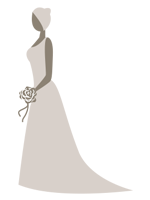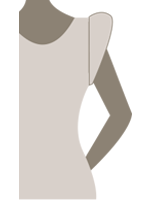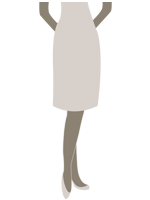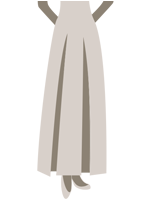Fashion Help & Tips
Dress Silhouettes
Silhouette refers to the overall cut of a gown. It's the most vital element to focus on, because a gown's shape is its foundation - it's what sets the mood for the entire garment. The fitted bodice and full bell-shaped skirt of the ball gown, for example, gives a princess-like presence. More form-fitting styles, like the A-line and sheath, offer a different appeal. The A-line elongates the line of the body, adding a classical elegance and the illusion of length. While the sheath ups the ante on wedding-dress sex appeal, creating a sleek and modern option for the more daring bride.

Click or tap to open and close
Wedding Dress Trains
A train can completely transform your look, no matter what shape your dress is. It allows you to change the feel of your outfit from ceremony to reception. The train is simply the elongated back portion of the gown that lies on the floor and trails behind the bride, the added weight demanding a tall and majestic stance. Trains date from the Middle Ages, when the length worn at court indicated a person's social rank. The premise being the wealthier you were, the more fabric you could afford. Today, gowns with long chapel and cathedral trains are considered the most formal, lending themselves to bustling following the ceremony. Watteau trains (which spill from the shoulder) and court trains (which start from the waist) are less formal. The sweep gently puddles about a foot behind the wearer, and the detachable train - which can be any length and either a flat panel or gathers of fabric - is generally attached to the gown at the waist with buttons or hooks, then later removed to be a bit less informal and not as imposing.

Click or tap to open and close
Dress Sleeves
Wedding dress sleeves have more impact than you may first realise. They can add interest to a bodice and provide balance for a skirt. Once closely linked to season, the selection of sleeve style is now largely a matter of how much - or how little - skin the wearer is willing (or allowed!) to show. Both options can be equally dramatic. Long-sleeved styles designed for maximum flair include the Juliet: a long, fitted sleeve with a short puff at the shoulder; and the bell, a sleeve narrow at the armhole and then wide at the wrist. On the other spectrum are alluring super-spare styles such as the petal and the cap, both of which offer just enough material to cover the shoulder. Sleeves don't have to be made from the same fabric as the gown, often they are made of tulle, lace, or illusion netting, which create a 'barely there' effect even when the sleeves are long.

Click or tap to open and close
Dress Necklines
The neckline is a very important feature on a wedding dress. Not only is it the part of the dress people spend the most time looking at, but it's also the one that draws attention to the face, the collarbone, and the décolletage (the low-cut neckline on a woman's dress). Some necklines - the bateau, jewel, and high collar - sit high on, or even cover the collarbone. Others - the portrait, sweetheart, scoop, keyhole, and strapless - are better known for what they leave bare. Because of its prominence, many brides use the neckline to add character to a gown, whether it's to show off an accessory, or to highlight a particular figure feature.

Click or tap to open and close
Dress Waistlines
We all know where the waistline is on our body, and most of us would probably like it a bit smaller. But in wedding dress terms (technically speaking), the waistline of the wedding dress is the horizontal seam that joins the bodice and skirt. Along with the neckline and sleeves, the waistline works to add signature style to a particular silhouette. It's also the element responsible for bringing shape and balance to your wedding dress. For example, the elongate V-shape of a Basque waist beautifully reins in a full ball gown, while the natural waist on an A-line dress will subtly highlight the gentle curve of the design. Waistlines can also be used to manipulate gown proportion. Dropped waists help create the illusion of a longer torso, while high Empire-style waists are favoured for their slimming properties.

Click or tap to open and close
Dress Skirts
Whether full or flared, the skirt is where much of a gown's personality can be found. A few well-placed details can add length and volume, romance and depth, making the difference between a gown that's average and one that's jaw-droppingly stunning. Some skirt details - strategically placed slits or pleats - can make the wedding dress more sexy; others, such as delicate flounces, can make it more poetic. Techniques like folds or draping, as well as overskirts and overlays, can add visual interest, while shapes like the mermaid and trumpet are pure drama. The bustle, for example, is where yards of fabric at the back of the skirt are gathered up and secured - a process known as 'bustling' - with a few discreet buttons or hooks following the ceremony or the first dance. The results in swaths of fabric that add fullness and fun once the formalities are completed. The length of your dress can dictate the formality of your wedding. Generally speaking, the longer the dress, the more formal the affair; floor-length is considered the most formal. Gowns that fall anywhere from mid-calf to the ankle are considered semiformal. And a gown that's knee length or shorter is said to be informal, though today the mini dress is considered a chic option for the unconventional or for the second-time bride.

Click or tap to open and close







